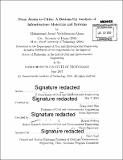| dc.contributor.advisor | Franz-Josef Ulm and Roland Pellenq. | en_US |
| dc.contributor.author | Abdolhosseini Qomi, Mohammad Javad | en_US |
| dc.contributor.other | Massachusetts Institute of Technology. Department of Civil and Environmental Engineering. | en_US |
| dc.coverage.spatial | n-us-ma | en_US |
| dc.date.accessioned | 2015-10-30T19:01:09Z | |
| dc.date.available | 2015-10-30T19:01:09Z | |
| dc.date.copyright | 2015 | en_US |
| dc.date.issued | 2015 | en_US |
| dc.identifier.uri | http://hdl.handle.net/1721.1/99617 | |
| dc.description | Thesis: Ph. D., Massachusetts Institute of Technology, Department of Civil and Environmental Engineering, 2015. | en_US |
| dc.description | Cataloged from PDF version of thesis. | en_US |
| dc.description | Includes bibliographical references (pages 261-303). | en_US |
| dc.description.abstract | Civil infrastructure is and continues to be the backbone of our society to meet our needs in housing, transportation, water and electricity supply, and so on. However, its functions are recently revisited in response to rising concerns about its certain sustainability aspects. These aspects include and are not limited to excessive greenhouse gas emissions, unreasonably high energy footprint, relatively short service life, low durability and poor resilience. This presents us with an exclusive opportunity to take these detrimental aspects seriously and turn them into exciting venues for research in the realm of civil and environmental engineering. These opportunities are disseminated across the entire infrastructure landscape, spanning several length scales starting from the molecular structure of construction materials to the entire global transportation network. From Atoms to Cities is intended to provide a multiscale bottom-up framework to seamlessly connect the heat transport through the molecular structure of construction materials to thermal energy losses at the city level. Separated by twelve orders of magnitude in length scales, from nanometers to kilometers, this provides a chance to link ideas in mechanics and physics of materials to analysis of complex systems. Two major impediments hinder any progress in pursuit of such a hierarchical multiscale model: the absence of a realistic molecular structure of construction materials such as Calcium-Silicate-Hydrates (C-S-H), the glue of concrete, and the multiplicity of factors affecting heat losses at large scales. The first is an indispensable requirement in statistical mechanics as it shapes the energy landscape. The second makes it rather impossible to quantitatively assess the impact of sustainability initiatives at the city scale. By combining the tool of statistical physics with combinatorial screening technique, we first construct a database of realistic molecular structures of C-S-H with varying calcium-to-silicon ratios and compare them against an extensive array of nanotextural and nano-mechanical experiments. A comprehensive analysis of this database reveals a deeper level of connection between cement science and glass physics. This includes the existence of anomalies in mechanical properties similar to that observed in rigidity transition windows in binary glasses and the presence of extra atomic vibrational modes at low THz regime known as Boson peak. These models are further utilized to calculate the heat capacity and transport properties using Green-Kubo formalism in equilibrium molecular dynamics. While considering other phases in cement paste, the use of mean-field homogenization technique enables us to upscale thermal properties from the nanoscale to the engineering macroscale. The macro-level thermal properties are subsequently compared with those measured experimentally throughout the cement's hydration process. Afterwards, we show that the building envelope's heat transport property is among the set a few influential parameters that affect heat losses at the city scale. This subset of key parameters makes it feasible to construct a high fidelity mechanistic-based reduced order model of heat losses at the building level. Together with energy consumption data of more than 6,200 buildings in Cambridge, MA, this model paves the way to find the shortest path to reduce heat losses in city's building block through retrofit. | en_US |
| dc.description.statementofresponsibility | by Mohammad Javad Abdolhosseini Qomi. | en_US |
| dc.format.extent | 303 pages | en_US |
| dc.language.iso | eng | en_US |
| dc.publisher | Massachusetts Institute of Technology | en_US |
| dc.rights | M.I.T. theses are protected by copyright. They may be viewed from this source for any purpose, but reproduction or distribution in any format is prohibited without written permission. See provided URL for inquiries about permission. | en_US |
| dc.rights.uri | http://dspace.mit.edu/handle/1721.1/7582 | en_US |
| dc.subject | Civil and Environmental Engineering. | en_US |
| dc.title | From atoms to cities : A bottom-up analysis of infrastructure materials and systems | en_US |
| dc.title.alternative | Bottom-up analysis of infrastructure materials and systems | en_US |
| dc.type | Thesis | en_US |
| dc.description.degree | Ph. D. | en_US |
| dc.contributor.department | Massachusetts Institute of Technology. Department of Civil and Environmental Engineering | |
| dc.identifier.oclc | 925539187 | en_US |
